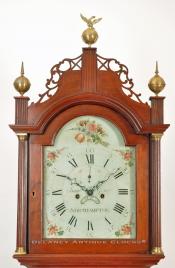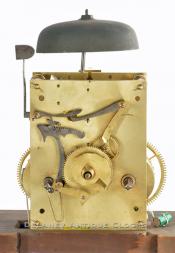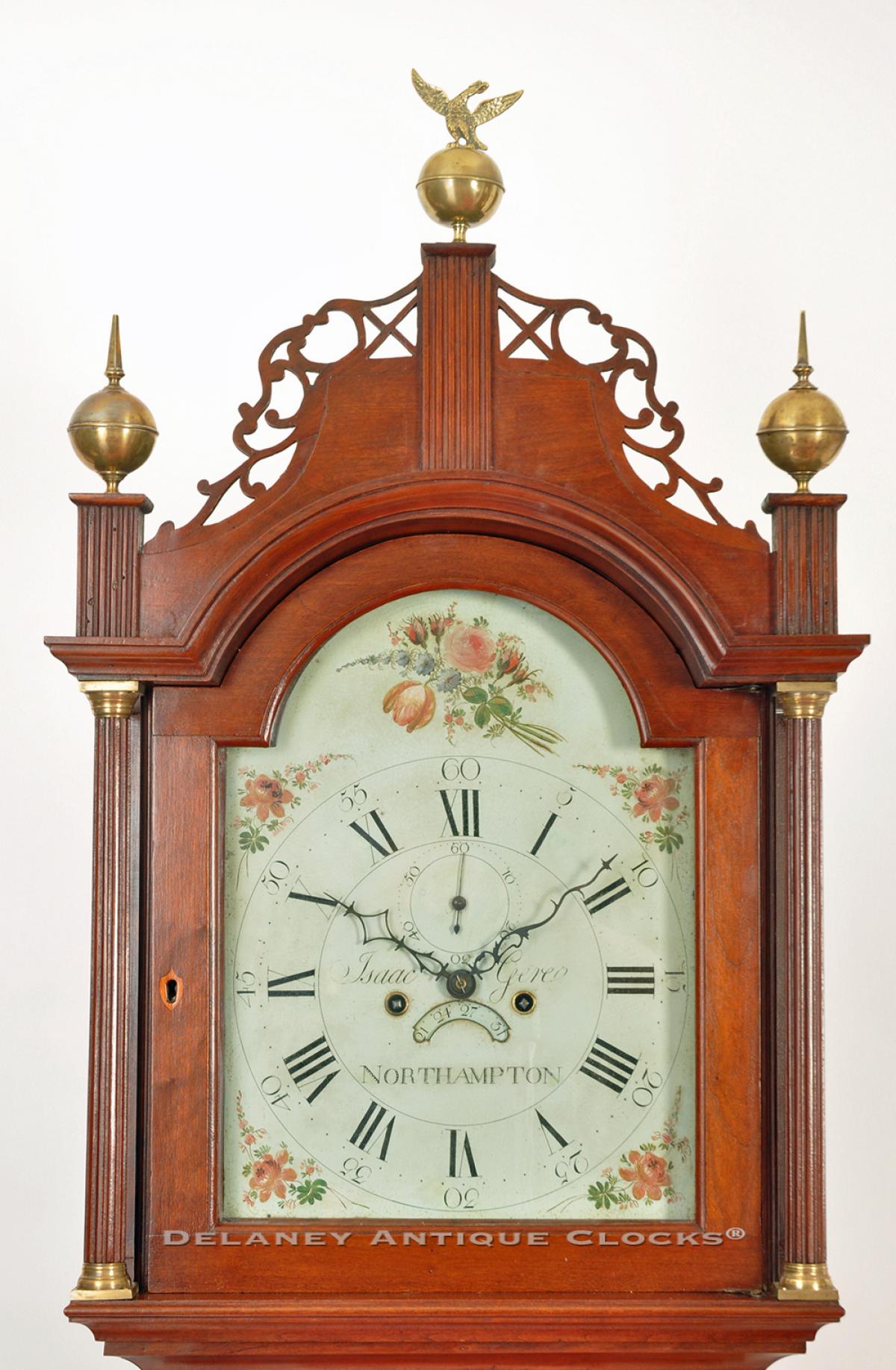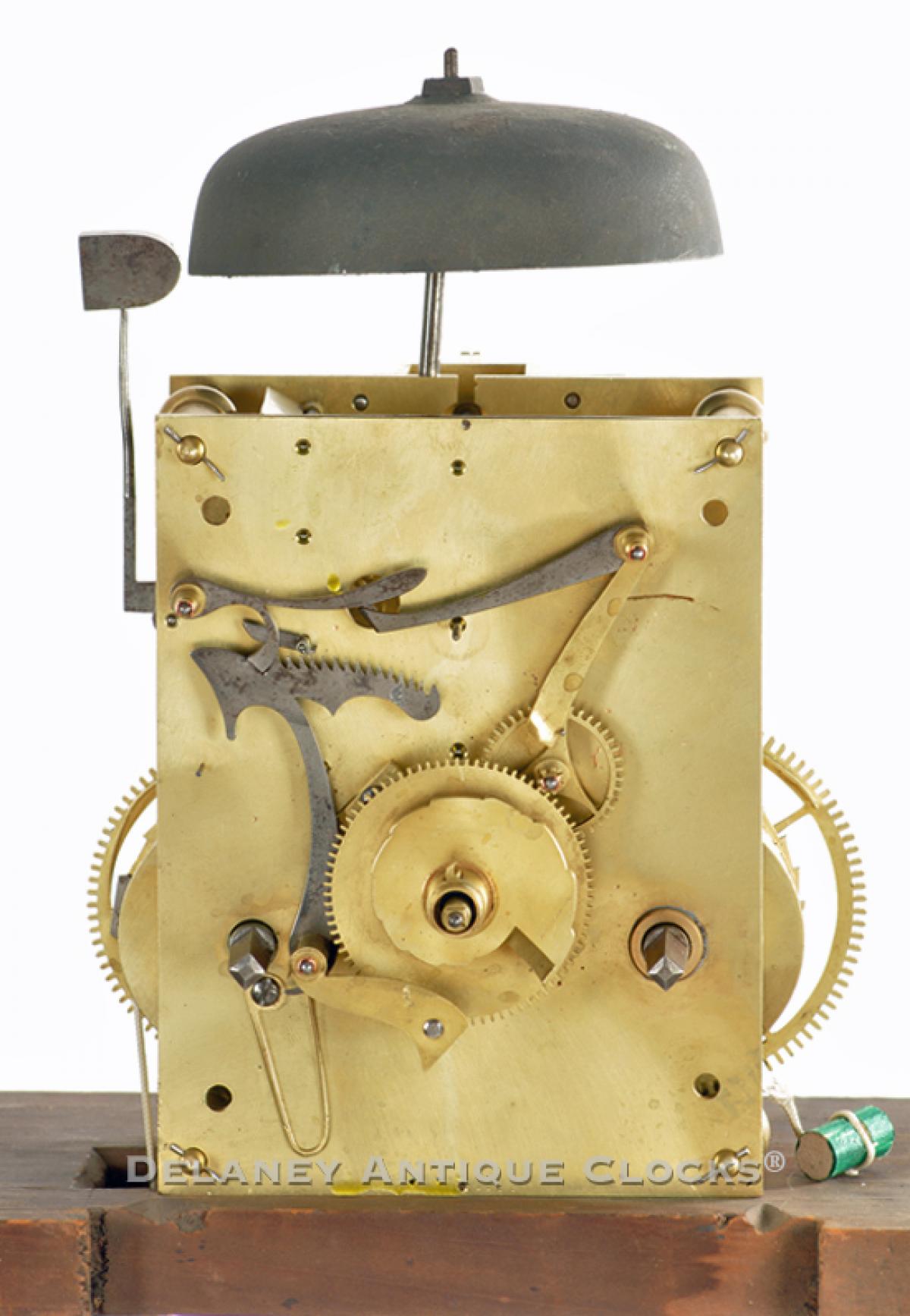Isaac Gere of Northampton, Massachusetts. A cherry case tall clock. The case attributed to Julius Barnard. TT-140.
This fine Connecticut River Valley cherry case tall clock was made by Isaac Gere (1771-1812) of Northampton, Massachusetts. The case is attributed to the Northampton cabinet maker Julius Barnard.
This fine cherry case exhibits a pleasing modern finish that is rich in color. It stands on four nicely shaped ogee bracket feet that are applied to the lower base molding. This molding is a double-step form and is attached to the base. The base transitions to the waist with a large cove waist molding. The waist section is proportionally long. It is fitted with a long waist door that is fancifully shaped at the top. The perimeter of the door is trimmed with a molded edge. A lock keeps this door secure, and a brass escutcheon frames the keyhole. Open this door, and one will gain access to the pendulum, comprised of an original steel rod and brass-faced bob. Two tin can drive weights are also accessible in the waist of the case. The sides of the waist are fitted with fluted quarter columns that terminate in turned wooden quarter capitals. The transition to the pagoda-style hood is through the use of a large cove molding. Fluted columns that terminate in turned wooden capitals visually support the molded arch molding of the bonnet. Above this arch, molding rests a pagoda top that is decorated with a pierced and open fretwork pattern, three tall reeded finial plinths, and brass finials. The bonnet door is an arched form and fitted with glass. It opens to access the painted iron dial.
This iron dial is colorfully paint decorated. The four spandrel areas and the arch of the dial are decorated with interesting floral themes. This dial also displays the hours, minutes, seconds, and calendar date in the traditional format. This dial is signed by the Clockmaker in large script lettering. It reads "Isaac Gere." The working location of "NORTHAMPTON" is painted in a block style. This can be found under the calendar display.
This movement is constructed in brass and is of good quality. Four distinctively shaped posts support the two large rectangular-shaped plates. Hardened steel shafts support the polished steel pinions and brass gearing. The winding drums are grooved. The escapement is designed as a recoil format. The movement is weight driven and designed to run for eight days on a full wind. It is a time-and-strike design having a rack and snail striking system. As a result, it will strike each hour on the hour. This is done on a cast iron bell which is mounted above the movement.
This beautiful clock was made circa 1800. It stands approximately 7 feet 11 inches tall to the top of the center finial.
Inventory number TT-140.
Isaac Gere was born in Preston, Connecticut, on December 6, 1771. His parents were Nathan and Jerusha (Tracy) Gere. It is believed that his early training in the art of clockmaking was under the guidance of John Avery, who also lived and worked in the same town. In 1793, Gere moved to Northampton, Massachusetts, where he was active as a watchmaker, clockmaker, and silversmith until his death on September 24, 1812.
Shortly after moving to Northampton, Gere hired Nichols Goddard as a journeyman clockmaker. Goddard records this in his journal. Nicholas stayed with Gere for three years and left for Rutland, Vermont, in 1797.
In June 1803, Gere took on Ebenezer Strong Phelps as an apprentice to learn silver and goldsmithing and make brass eight-day clocks. Ebenezer was fifteen years old. In January 1809, with Ebenezer's parents' consent, Isaac sent Ebenezer to Newark, New Jersey, to work in the jewelry business for Messrs. Hinsdale and Taylor.
It is worth noting that the "Hampshire Gazette" carried a fair number of ads (June 1802-June 1803) stating that Gere was a clockmaker and watchmaker and also manufactured silver spoons, gold beads, etc. Gere's later ads (1809-1810) stated that he is "at his brick store opposite the meetinghouse and continues to make every article in the gold and silversmith business."
A small number of tall case clocks are currently known. Two of these clocks share very similar cases. One is a clock that we have owned. A second clock is pictured in Fales's book, The Furniture of Historic Deerfield, on page 264. This clock shares a very similar case, which is credited to having been made by Julius Barnard. Eliphalet Chapin trained Julius Barnard (1741-1807) of East Windsor, Connecticut. He moved up to Northampton and set up his cabinet shop. Naturally, much of his furniture exhibits a strong Chapin influence. The Williams and Billings families of Hatfield and Deerfield once owned the clock pictured in Fales. A third example is pictured in the Sack Volumes, No. 2 on page 303. This clock is now reported to be in The Ford Museum. It differs significantly in case form.
In January 2011, George Thomas Lewis & Co. sold the portraits of Isaac Gere and his wife, painted by Ralph Earl, at a public auction. Isaac is pictured seated, very well dressed, with an open book in front of him on a table. In the background, behind the fancy drapes, is a view of the Connecticut River Valley.










